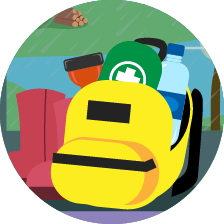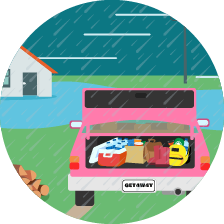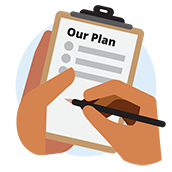Get winter ready
Are you emergency-ready this winter? Winter can often bring severe weather, but no matter the weather it's a good idea to be prepared.
On this page
Make a winter ready plan
Emergencies can happen anytime, anywhere, and often without warning. A household emergency plan lets everyone in your household know what to do in an emergency and how to get ready. Having a plan helps make actual emergency situations less stressful.
Make a plan
Work out what supplies you need at home

If you're at home, you probably have most of the things you need already. You don’t have to have them all in one place, but you might have to find them in a hurry and/or in the dark.
- Water for three days or more — make sure you have at least nine litres of water for every person. This will be enough for drinking and basic hygiene.
- Long-lasting food that doesn’t need cooking (unless you have a camping stove or gas barbecue) and food for babies and pets.
- Toilet paper and large plastic buckets for an emergency toilet.
- Work gloves and a properly-fitted P2 or N95 mask.
If you have special dietary needs, make sure you have enough to last three days at home.
Don't forget that you and your neighbours can help each other by sharing supplies too.
Pack your grab bag

In an emergency, you might have to evacuate quickly, or you might not be able to get home.
Have grab bags ready for everyone in your family. A grab bag is a small bag with essential supplies.
Each bag should have:
- Walking shoes, warm clothes, raincoat and hat
- Water and snack food (remember babies and pets too)
- Hand sanitiser
- Portable phone charger
- Cash
- Copies of important documents and photo ID
- Medications
- First aid kit
- Torch and batteries
Pack your car

A flood, snow storm or major traffic accident could leave you stranded in your vehicle for some time.
Keep essential emergency survival items in your car. If you are driving in extreme winter conditions, add:
- a brush
- a shovel
- tire chains
- windshield scrapers, and
- warm clothing.
Prepare for any kind of weather
Winter can bring all kinds of weather. Make sure you're ready in case severe weather hits your area.

Keep an eye on the weather
MetService provides land-based severe weather alerts. These are issued through a system of Outlooks, Watches and Warnings. Check what weather alerts are in place for where you are.
Check for weather alerts
Find out your flood risk
Find out from your local council if your home or business is at risk from flooding and how they’ll alert you if you need to evacuate. They may have resources and information on how to reduce potential flood damage.
Find your council
Plan your travel
Severe weather can make it unsafe to travel. Floods, landslides and snow can all block and damage roads.
Never try to walk, swim or drive through flood water. Many flood fatalities are caused by people attempting to drive through water.
If you have to travel in the snow, make sure you are well prepared. Take snow chains, sleeping bags, warm clothing and essential emergency items.
Plan your journey with Waka Kotahi. See what traffic updates or delays are on your route. Only travel if it is safe to do so.
Plan your journey
Plan for no power
What would you do if the power was out for days? How will you see, cook, keep warm?
If the power goes out, eat the food from your fridge first, then your freezer. Then eat the food in the cupboard or your emergency kit.
If you live in a region at risk of snowstorms, make sure you have more than one form of power generation and heating.
Check the impactsPrepare your property for severe weather
It’s good to plan for what you will need to do to make your property safe in severe weather.
Make a list of items to bring inside or tie down when strong winds are forecast. A list will help you remember anything that strong winds can break or pick up.
If high winds are forecast, close doors and windows and pull curtains and blinds over windows.
Make a list of items inside that you will need to move before a flood. You’ll need to move valuable and dangerous items as high about the floor as possible. Use watertight containers to store important items.

Get Ready
There are simple steps you can take to make sure you and your whānau are ready to get through.


